The NVIDIA GeForce RTX 2080 Ti & RTX 2080 Founders Edition Review: Foundations For A Ray Traced Future
by Nate Oh on September 19, 2018 5:15 PM EST- Posted in
- GPUs
- Raytrace
- GeForce
- NVIDIA
- DirectX Raytracing
- Turing
- GeForce RTX
Wolfenstein II: The New Colossus (Vulkan)
id Software is popularly known for a few games involving shooting stuff until it dies, just with different 'stuff' for each one: Nazis, demons, or other players while scorning the laws of physics. Wolfenstein II is the latest of the first, the sequel of a modern reboot series developed by MachineGames and built on id Tech 6. While the tone is significantly less pulpy nowadays, the game is still a frenetic FPS at heart, succeeding DOOM as a modern Vulkan flagship title and arriving as a pure Vullkan implementation rather than the originally OpenGL DOOM.
Featuring a Nazi-occupied America of 1961, Wolfenstein II is lushly designed yet not oppressively intensive on the hardware, something that goes well with its pace of action that emerge suddenly from a level design flush with alternate historical details.
The highest quality preset, "Mein leben!", was used. Wolfenstein II also features Vega-centric GPU Culling and Rapid Packed Math, as well as Radeon-centric Deferred Rendering; in accordance with the preset, neither GPU Culling nor Deferred Rendering was enabled.
| Wolfenstein II | 1920x1080 | 2560x1440 | 3840x2160 |
| Average FPS |  |
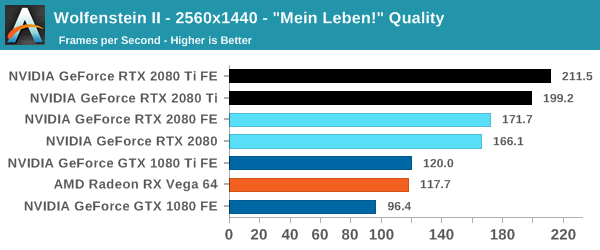 |
 |
| 99th Percentile | 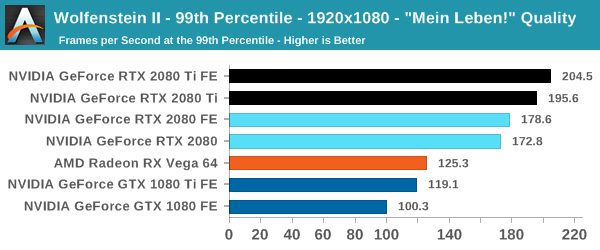 |
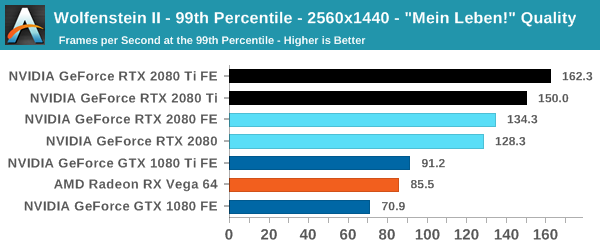 |
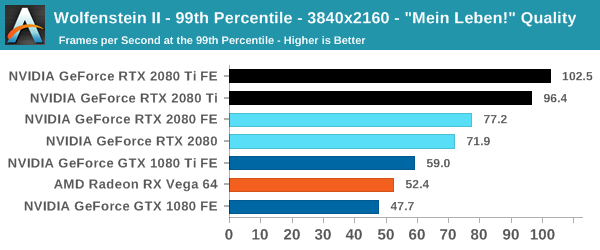 |
I am actually impressed with Wolfenstein II and its Vulkan implementation more than the absurd 250+ framerates, if only because many other games hold back the GPU because of the occurring CPU bottleneck. In DOOM, there was a hard 200fps cap because of engine/implementation limitations, a bit of a corner case, but manufacturers make 240Hz monitors nowadays, too. On a GPU performance profiling side, of course, reducing the CPU bottleneck makes comparing powerful GPUs much easier at 1080p, and with a better signal-to-noise than at 4K.
This is combined with the fact that at 4K, the 20 series are looking a huge 60 to 68% lead over the 10 series, and we'll be cross-referencing these performance deltas with other sections of the game. Even in the case of a 'flat-track bully' scenario where the 2080 Ti is running up the score, the 2080 Ti's speed compared to the 2080 is somewhat less than expected at 24 to 27%. It's a somewhat intriguing result for an optimized Vulkan game, as the game runs and scales generally well across the board; It's also not unnoticed that both the RX Vega cards and GeForce Turing cards outperform their expected positions, though without the graphics workload details it's hard to speculate with substance. With framerates like these, the 4K HDR dream at 144 Hz is a real possibility, and it would be interesting to compare with Titan V and Titan Xp results.


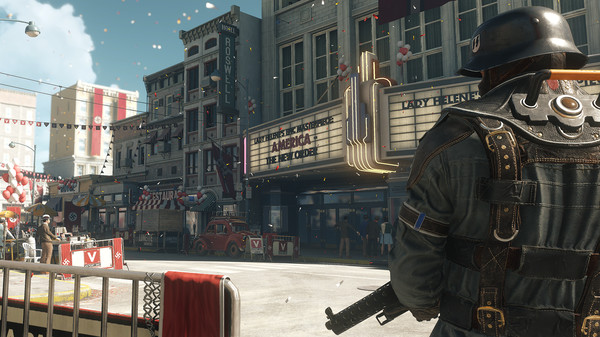









337 Comments
View All Comments
Fritzkier - Wednesday, September 19, 2018 - link
Blame both. Why the f you blame AMD for NVIDIA's own fault?And yes, AMD had competitive offering on mid-end, not on high end. But, that's before 7mm. Let's see what will we got on 7mm. 7mm will be released next year anyway, it's not that far off.
PopinFRESH007 - Wednesday, September 19, 2018 - link
Yep, lets wait for those 7mm processes. Those chips should only be the size of my computer with a couple hundred thousand transistors.Holliday75 - Friday, September 21, 2018 - link
Haha I was about to question your statement until I paid more attention to the process size he mentioned.Fritzkier - Saturday, September 22, 2018 - link
We seriously needs an edit button. Thanks autocorrect.Yojimbo - Wednesday, September 19, 2018 - link
So you are saying that if AMD were competitive then NVIDIA could never have implemented such major innovations in games technology... So, competition is bad?dagnamit - Thursday, September 20, 2018 - link
Competition can stifle innovation when the market is involved in race to see how efficiently they can leverage current technology. The consumer GPU market has been about the core count/core efficiency race for a very long time.Because Nvidia has a commanding lead in that department, they are able to add in other technology without falling behind AMD. In fact, they’ve been given the opportunity to start an entirely new market with ray-tracing tech.
There are a great many more companies developing ray-tracing hardware than rasterization focused hardware at the current moment. With Nvidia throwing their hat in now, it could mean other companies start to bring hardware solutions to the fore that don’t have a Radeon badge. It won’t be Red v. Green anymore, and that’s very exciting.
Spunjji - Friday, September 21, 2018 - link
Your Brave New World would involve someone else magically catching up with AMD and Nvidia's lead in conventional rasterization tech. Spoiler alert: nobody has in the past 2 decades and the best potential competition, Intel, isn't entering the fray until ~2020dagnamit - Sunday, September 23, 2018 - link
No. I’m saying that companies that specialize in ray-tracing technology may have an opportunity to get into the consumer discrete GPU market. They don’t need to catch up with anything.eva02langley - Thursday, September 20, 2018 - link
Not AMD fault if Nvidia is asking 1200$ US. Stop blaming AMD because you want to purchase Nvidia cards at better price, BLAME Nvidia!It is not AMD who force Ray Tracing on us. It is not AMD who want to provide gamework tools to sabotage the competition and gamers at the same time. It is not AMD charging us the G-sync tax. It is not AMD that screw gamers for the wallet of investors.
It is all Nvidia fault! Stop defending them! There is no excuses.
BurntMyBacon - Thursday, September 20, 2018 - link
I accept that nVidia's choices are their own and not the "fault" of any third party. On the other hand, nVidia is a business and their primary objective is to make money. Manufacturing GPUs with features and performance that customers find valuable is a tool to meet their objective. So while their decisions are their own responsibility, they are not unexpected. Competition from a third party with the same money making objective limits their ability to make money as they now have to provide at least the perception of more value to the customer. Previous generation hardware also limits their ability to make money as the relative increase in features and performance (and consequently value) are less than if the previous generation didn't exist. If the value isn't perceived to be high enough, customers won't upgrade from existing offerings. However, if nVidia simply stops offering previous generation hardware, new builds may still be a significant source of sales for those without an existing viable product.Long story short, since there is no viable competition from AMD or another third party to limit nVidia's prices, it falls to us as consumers to keep the prices in check through waiting or buying previous gen hardware. If, however, consumers in general decide these cards are worth the cost, then those who are discontent simply need to accept that they fit into a lower price category of the market than they previously did. It is unlikely that nVidia will bring prices back down without reason.
Note: I tend to believe that nVidia got a good idea of how much more the market was willing to pay for their product during the mining push. Though I don't like it (and won't pay for it), I can't really blame them for wanting the extra profits in their own coffers rather than letting it go to retailers.